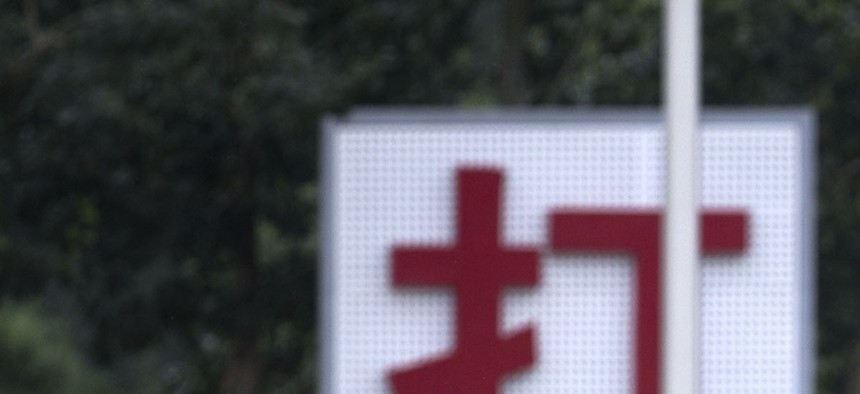
Chinese People's Liberation Army cadets take part in bayonet drills at the PLA's Armoured Forces Engineering Base, in Beijing, China, on July 22, 2014. Andy Wong/AP
Are the Chinese Failing To Equip Their Infantry?
Beijing is paying considerably more attention to platform and weapons development than it is to how well it outfits its individual soldiers. By Lauren Dickey and Emerson Brooking
A recent report by the Guangzhou-based Southern Weekly on investments to outfit and equip Chinese soldiers in the People’s Liberation Army (PLA) has sparked controversy both within China and abroad—revealing sharp fissures in China’s ballooning defense budget. With a total defense budget estimated at $132 billion in 2014 and 2.28 million active duty soldiers on payroll, the PLA allocates a mere $1,523 (9,460 yuan) in outfitting each soldier, roughly one-thirteenth the value of the average deploying U.S. serviceman’s personal gear. At a time when the combat-readiness of China’s armed forces is already widely debated, costs of the basic infantrymen kit highlight critical shortcomings of the Chinese military.
Official Chinese reports note an increase in Chinese military spending of 12.2 percent over the last calendar year; yet, amid such hefty increases, the individual equipment costs for PLA soldiers remains exactly the same as five years ago. The most expensive item a PLA soldier is issued—a Type-95 automatic rifle—rings in at 4,300 yuan ($690). Helmets, the second most expensive item on standard issue for PLA soldiers, cost approximately 1,580 yuan ($255).
The helmet, as well as other equipment PLA infantrymen are issued, is old technology, lacking upgrades necessary for the modern era of warfare. Helmets are mostly World War II-era steel, not modern kevlar. Two radio sets are issued per company; not even compasses come standard issue. Despite efforts to increase military procurement, Beijing has not fully realized the importance of investing in the core of its military forces: the troops.
These numbers reveal a vast gulf in perspective between Chinese and American force planners. According to a 2007 investigation by the Associated Press (and adjusted to 2014 dollars), the average American serviceman deploys with nearly $20,500 in personal kit. This figure represents a range of protective gear: advanced body armor, padding, gas masks, and sophisticated optics. New personal-issue tech looming on the horizon may soon push this number even higher. The Army Ground Soldier System, essentially a beefed-up smartphone intended for team leaders, currently costs nearly $18,000 per unit.

A 2007 study by the Associated Press tracked the average cost of a deployed U.S. soldier’s uniform and equipment cost across different eras. Adjusted to 2014 dollars, it cost roughly $200 for an American serviceman in WWII; $1,300 in Vietnam; and $20,500 for Afghanistan and Iraq-deployed servicemen. Dependent on acquisitions and tehchnology breakthrough, the future equipment cost of a U.S. soldier might rise as high as $70,000.
Interestingly, the cost of a U.S. Army standard-issue M4 carbine— $768 according to the U.S. Army’s 2015 budget request—sees virtual parity with the $690 Chinese Type-95. The PLA still wants its soldiers to shoot reliably and accurately, but is much less concerned with what happens when the enemy shoots back.
To be clear, there are important caveats when comparing Chinese and U.S. defense spending. Thanks to the role of purchasing power parity (PPP)—what The Economist tracks in its “Big Mac Index”—goods are simply cheaper in some places than others, even when adjusted across currencies. In 2014, a Chinese Big Mac cost roughly half of an American one. Moreover, China—unlike the United States —has not undertaken large, systematic combat deployments. China’s wartime kit could prove considerably more expensive. Because a large Chinese deployment has not happened (and ideally will not happen), costs for a Chinese wartime kit remain unknown.
Nonetheless, the Chinese military is paying considerably more attention to platform and weapons development than to outfitting its troops. A modern PLA soldier’s equipment compares poorly even to that of a Vietnam-era American draftee. It’s particularly ironic that the world’s largest exporter of body armor has reserved so few sets for its own military personnel.
The PLA is at a critical juncture. Gone are the days of simple fighting and Mao Zedong’s calls for Chinese to leave their farms, with guns in hand, to fight bravely on behalf of the communist cause. As President Xi Jinping spearheads a range of initiatives to modernize China’s military structure, the Chinese leadership must also determine how to support a transition to a professional fighting force. While modern China no longer faces fiscal shortages of the past, PLA personnel seem reluctant to invest in infantrymen, couching their defenses of Beijing’s sparse investment choices in communist revolutionary terms. In a military doctrine that emphasizes strength of spirit, they say, excessive protective equipment can only sap the strength of infantrymen, weakening morale and encouraging indulgence.
So long as Beijing outfits its soldiers at bottom-barrel prices—failing to modernize critical components of individual troop equipment— its readiness will suffer. The American military passed an important evolutionary milestone when it transitioned from a model of mass attrition to individual force protection. If China wants to realize its long-term military aspirations, PLA defense planners will one day have to contend with the same challenge.
This post appears courtesy of CFR.org.